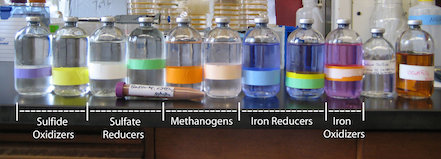
Microbiology on IODP Leg 330
Hi! My name is Jason Sylvan. I am a microbiologist at University of Southern California, and I will be keeping a blog throughout IDOP Leg 330 to the Louisville Seamount Chain describing some of the research that I do, the technology we use to collect samples from below the seafloor, and life on a research vessel.
I study deep-sea microbes, or unicellular organisms, from the Bacteria and Archaea, the two exclusively unicellular Domains of life. I am very excited to sail with Leg 330, which is my first seafloor drilling cruise (so you will be learning at the same time that I do)! I joined this cruise is because we will be collecting A LOT of subsurface (below the seafloor) basalt, which is all potentially home to interesting microbes for me to study.
Much of the seafloor looks like a sandy beach, but below this sand, or sediment, lies old, volcanic rock (primarily basalt, just like you see if you visit Volcano National Park on Hawaii) that was originally formed at mid-ocean ridges (a 70,000 km long underwater mountain range) and then transported away from the ridges due to plate tectonics. This basaltic rock is permeable, which means water can and does flow through it. And anywhere water flows life can exist. Leg 330 is particularly exciting because we will be sampling very old rocks: 55-80 million years old! Before this cruise, nearly all of the microbiology studies of subsurface basalts, which I can count on one hand, were from young (<5 million years old, which is young on a geological scale!) rocks, so I am excited to see what I discover from the samples we will collect.
One of my goals on this cruise is to culture, or grow, microbes from subsurface basalts. To do so, I made artificial media in my lab that mimics the subseafloor environment and encourages specific types of microbes to grow (see the figure- below the different bottles, I indicate what types of microbes I hope to grow with those bottles). You’ll notice that the media are a range of colors from clear to pink to blue. This is because I need to know if there is no oxygen (clear), some oxygen (pink) or a lot of oxygen (blue) in my media and therefore added an chemical indicator that tells me relatively how much oxygen may be present (none, some, or a lot). Some of the different microbes I am interested in growing require that no oxygen be present because it is poisonous to them. These include the methanogens and sulfate reducers, two types of microbes likely to be present in the rocks I will be collecting. You can also see some chemicals I will add to some of these media later, including goethite, which is an iron oxide (rust!), and iron chloride, at the far right. When we start collecting rocks, I will add them to bottles with these different media and keep my fingers crossed that something grows!
Stay tuned for more updates on microbiology, life on a research ship, and some of the amazing technology we are using to collect our samples!